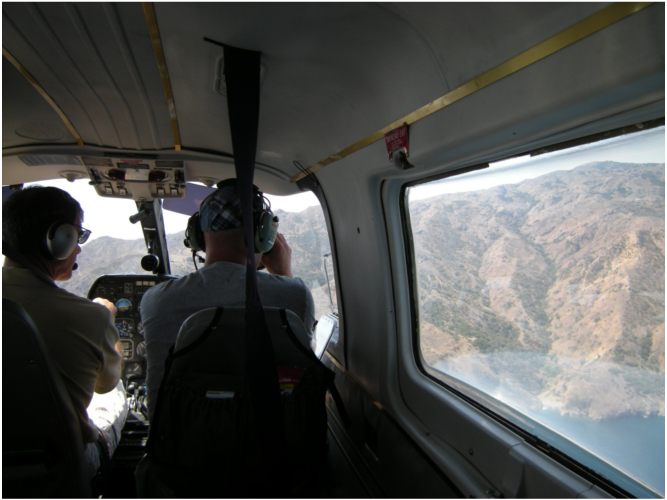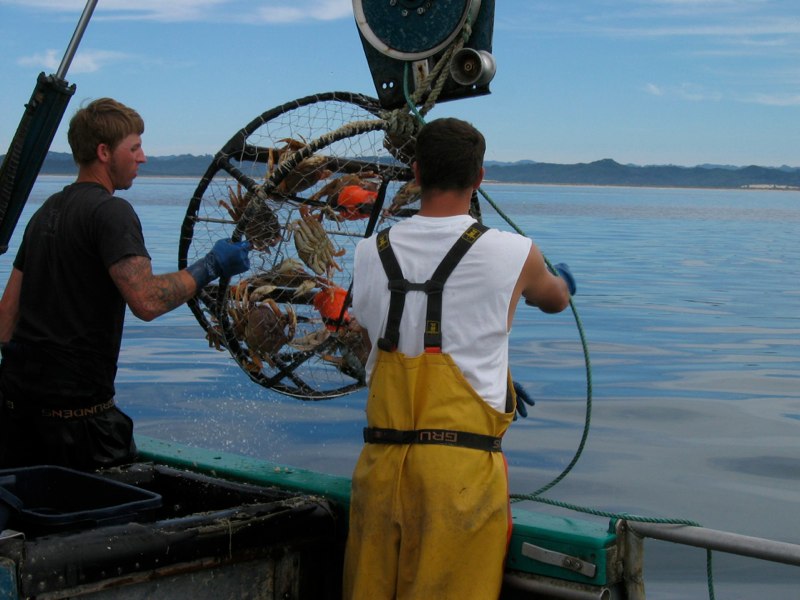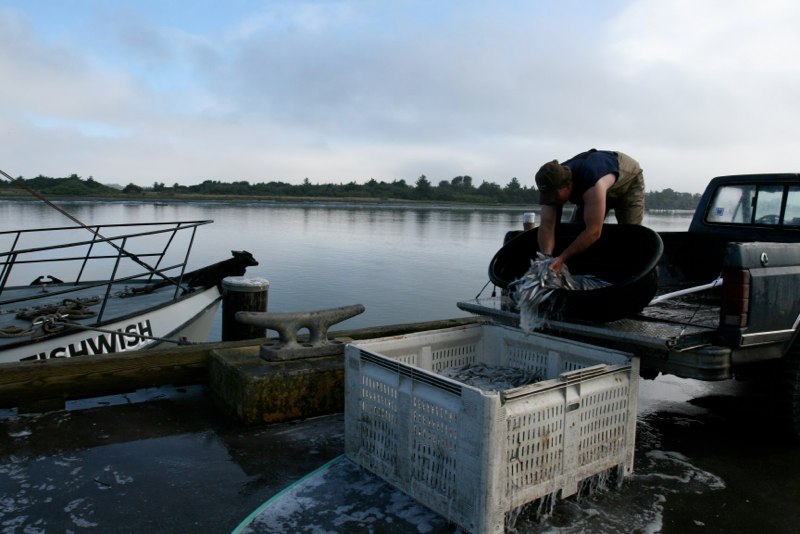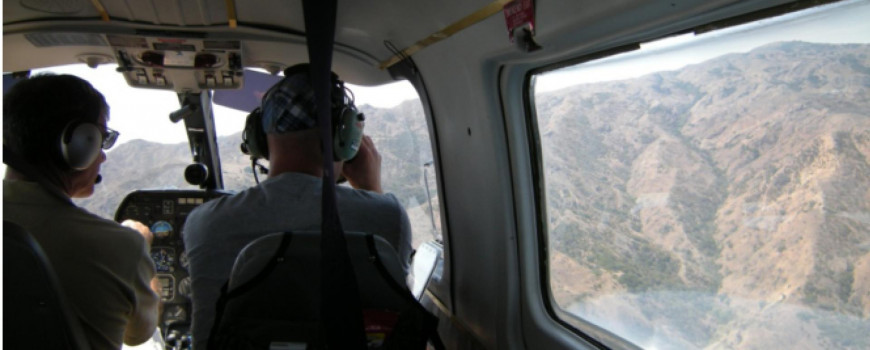Bycatch reduction, gear recovery and direct-seafood marketing are among the topics currently addressed through collaborative research with commercial and recreational fishermen.
Other projects examine rockfish populations within the Rockfish Conservation Areas; yellowtail movement patterns in Southern California, and spawning populations of night smelt along the North Coast.
All of the projects are unique in that fishermen are in some way directly involved with the research. They may have initiated the project’s basic concept, or they may be helping to collect data. In some cases, they are also helping analyze it. The unifying theme is that both anglers and commercial fishermen are engaged in work that often, previously has been isolated within academic or management circles.
California Sea Grant supports this innovative research through our partnership with the non-profit Collaborative Fisheries Research West, funded by the California Ocean Protection Council. California Sea Grant Extension specialists are lead investigators on several of the projects, as well.
The 12 projects listed below include both large, multi-year grants, with awards ranging from $206,000 to $242,000 plus matching funds, and mini grants, with awards at or below $25,000 plus matching funds.
An Assessment of the Responses of Rockfish Populations to Rockfish Conservation Area Closures in the Cordell Bank and Gulf of the Farallones National Marine Sanctuaries
R/OPCCFRW-1 Jul. 2012–Jun. 2014
Richard Starr, MLML, 831.771.4442,starr@mlml.calstate.edu
Susan Sogard, NOAA Fisheries, 831.420.3932,susan.sogard@noaa.gov
Large swaths of the seafloor off the U.S. West Coast have been closed to fishing for bottom fishes —to rebuild overfished stocks, such as bocaccio, canary rockfish, cowcod and dark-blotched rockfish. This project will assess how fish populations within Rockfish Conservation Areas (RCAs) off Central California have responded since the closures went into effect in 2002. Teams of volunteer anglers are key to the project, as they are boarding charted passenger sport fishing vessels to help scientists conduct repeat hook-and-line surveys of four sites—two within the RCAs and two outside them. On these rigorously designed “fishing trips,” fish are being caught, measured, tagged and released (for a recapture study later). To the extent possible, the sampling methods and subsequent data analysis will replicate a similar angler survey program led by the California Department of Fish and Wildlife from 1987 to 1998. The primary goals of the project are to compare catch rates, species composition and fish sizes inside and outside the RCAs before and after the closures, as well as patterns that may be more likely attributable to shifts in ocean climate. These climatic factors could favor one species over another irrespective of fishing pressure. In addition to the angler surveys, scientists will collect female rockfishes (from six species) during the winter spawning season to document relationships between female rockfish fecundity and body size, age, liver weight and lipid stores. This component of the project is a collaboration with NOAA’s Cooperative Research Program. The scientists will be analyzing data in the coming months and plan to have some results in early 2014.
Integrating Collaborative Data Collection with Management: A Lobster Fishery Test Case
R/OPCCFRW-2 Jul. 2012–Jun. 2014
Carolynn Culver, CASGEP, 805.893.4530, cculver@ucsd.edu
Stephen Schroeter, UCSB, 760,438.5953, schroter@lifesci.ucsb.edu
Caroline Pomeroy, CASGEP, 831.459.4173, cpomeroy@ucsd.edu
Doug Neilson, CDFW, 858.467.4229, Douglas.Neilson@wildlife.ca.gov
Could commercial lobster-trap fishermen help gather and interpret data for long-term, cost-effective fisheries management? This project addresses this question, building on an at-sea sampling program for the southern rock crab fishery that was developed by the project’s lead scientists. During the CFR West project’s first year, fishermen, scientists and managers worked together to develop and test protocols for collecting different types of data. They are also determining how to integrate those protocols with different kinds of commercial lobster fishing operations. In August 2013, the scientists reported that they were in the process of analyzing data collected during the previous fishing season (2012-13) to identify the types of data most needed for management (i.e., data that varies among fishing locations) and an associated sampling regime for the upcoming 2013-2014 lobster season that ensures scientific rigor while minimizing impacts on the program’s fishing partners. In addition, fishermen, scientists and managers involved in the project have been discussing ideas for storing and sharing data, and for continuing the program into the future. To help identify some options, the lead scientists have been gathering information on other similar fishermen-based data collection programs. Ultimately, the group will hold a workshop to share results and evaluate the program’s long-term feasibility.
Mortality and Population Abundance of Three Species of Paralabrax off San Diego
R/OPCCFRW-3 Jul. 2012–Jun. 2014
Brice Semmens, UCSD/SIO, 858.822.0518, bsemmens@ucsd.edu
Ed Parnell, UCSD/SIO, 858.822.2701, eparnell@ucsd.edu
In this project, anglers are catching, tagging and releasing calico bass and barred sand bass on chartered sportfishing trips to select sites inside and outside the new South Coast marine protected areas (MPAs), as well as during catch-and-release sportfishing tournaments. Besides tagging fish, they are recording fish sizes, the gears used to catch fishes and evidence of pressure-induced injuries (barotrauma). A sample of bass are also being put in pens and observed to estimate mortality rates from catch-and-release practices. Private boat owners are helping researchers catch, tag and release spotted bay bass, which reside in bays. In addition to the angler data, about 50 barred sand bass will be caught at a spawning aggregation in the new South La Jolla Marine Reserve, surgically implanted with acoustic tags, and tracked via a deployed listening array for up to a year. Data will be used to study fish movement patterns, including “spill over” from MPAs, and to estimate spawning biomasses and mortality rates from predation, fishing and catch-and-release. As of August of 2013, volunteer anglers and researchers had tagged more than 8,500 bass from Imperial Beach north to Long Beach. The scientists also deployed the acoustic hydrophone array. Some of the project’s preliminary results suggest that all three bass species are likely to survive catch-and-release and that recaptured fish have relatively small home ranges (i.e., limited movements), with some exceptions. A few barred sand bass tagged in San Diego Bay, for example, were subsequently recaptured off the Tijuana Flats, and one tagged kelp bass traveled from La Jolla to San Clemente in southern Orange County. Scientists say that the continued accumulation of tagging and tracking data will provide highly valuable information for models of marine bass movement, mortality, and stock abundance. Some of the team’s outreach activities, to date, have included hosting booths at the annual Fred Hall Fishing and Boat shows, giving talks to local fishing clubs and making themselves readily available to various media outlets.
Targeting Swordfish Deep During the Day to Reduce Bycatch
R/OPCCFRW-4 Oct. 2012–Sep. 2014
Chugey Sepulveda, Pfleger Institute of Enviromental Research, 760.721.1404, chugey@pier.org
Heidi Dewar, NOAA/NMFS, 858.546.7023, Heidi.Dewar@noaa.gov
In this collaborative fisheries research project, scientists are tagging and tracking swordfish to learn more about the billfish’s movement patterns in relation to sea turtle habitat. The team is also collaborating with the fishing industry to test two innovative gear modifications for reducing bycatch in the commercial swordfish fishery off California. The key idea behind the gear modifications is to set hooks at depths that will efficiently target (catch) swordfish but not sea turtles and marine mammals closer to the sea’s surface. One experimental gear modifies a deep-set buoy configuration currently used by small-boat swordfish fishermen off Florida. The other is a deep-set long-line for larger fishing vessels. Both were pilot tested successfully by the lead investigators in 2011. In 2012-2013, PIER scientists tagged 10 swordfish within the Pacific Leatherback Closure Area, established to protect the critical habitat of migrating leatherback sea turtles. The tracking data is being used to characterize swordfish habitat and tailor the trial deep-set operations. The NOAA Fisheries team meanwhile has been conducting field trials of the deep-set longlines and in 2012 made 17 deployments in waters off Central and Southern California, with hooks set at an average depth of 235 meters. With this configuration, researchers caught a range of marketable species, including one swordfish, 37 opah and two albacore tuna. Bycatch was dominated by blue sharks. There were no sea turtle or marine mammal interactions. The coming year’s field work will focus on figuring out why so few swordfish were caught and whether different strategies might increase swordfish catches, while still minimizing sea turtle interactions.
Mini Grants
Collaborative Fisheries Research to Build Socioeconomic Essential Fishery Information: A Test Case
R/OPCCFRW-7MG Apr. 2013–Mar. 2014
Caroline Pomoroy, SGEP, 831-459-4173, cpomeroy@ucsd.edu
Monica Galligan, CSUMB, 831-582-4743, mgalligan@csumb.edu
Paul Reilly, CDFW, 831-649-2879, preilly@dfg.ca.gov
Carolyn Culver, SGEP, 805-893-4530, cculver@ucsd.edu
A California Sea Grant Coastal Specialist is leading a one-year socioeconomic study of the commercial California halibut fishery, in partnership with the commercial fishing community and state fisheries managers. The project’s focus is on the human system—the players, places and processes that interact with the ecological system. The team has begun to review trends in commercial catches of the species by port, where the fish are landed, and by the gear used to catch the fish. Once the existing data has been assembled, scientists will work with fishermen to interpret the trends and explain why they are occurring. The goal is to develop a collaborative process and template for documenting, evaluating and predicting change in the fishery’s human system, which can be adapted for use in other fisheries. The work will be iterative, and will include vetting and refining the initial results with a larger group of commercial California halibut fishery participants before the final results are made public. A final summary report will be posted on the California Sea Grant and California Department of Fish and Wildlife websites.
Testing the feasibility of urban coastal direct seafood markets
R/OPCCFRW-8MG; 7/1/13 – 6/30/14
Theresa Sinicrope Talley, California Sea Grant Extension Program, 858.200.6975, tstalley@ucsd.edu
Adina Batnitzky University of San Diego, abatnitzky@gmail.com
The goal of this project is to facilitate a diverse and local sustainable fishing industry by raising public awareness of the benefits and value of supporting locally caught and grown fish and shellfish. The scientists will meet this goal “using an inductive approach by leveraging San Diego’s ethnic diversity and desire for healthier diets, and the Port of San Diego s collaborative plan for two direct seafood markets.” The project has four main objectives: to 1) determine public demand for local product and the ability of fishers and growers to supply consumers with products they will purchase, 2) identify and address limitations to the public consuming more seafood, 3) raise public awareness of the local fishing industry and diversity of its products and 4) identify species of emerging public interest to facilitate the development of management strategies before demand increases. On September 2, 2013, the scientists and their many collaborators hosted a seafood tasting, survey and outreach event at San Diego Bay. At the highly successful event, about 200 participants voted on their likelihood of buying species they had just sampled in expertly prepared dishes and they took a 30-minute survey on their knowledge and interest in local seafood. There was also public information on seafood nutrition, and separate morning and afternoon events to better reach key audiences, namely East African American women and urban seafood consumers likely to support the locavore movement. Analyses of the survey results are ongoing. In the coming months, scientists will hold workshops aimed at San Diego’s fishermen and aquaculturists and San Diego consumer groups, and will follow up with each of the groups surveyed.
Cooperative tagging and tracking of yellowtail to assess recruitment and residency in the Southern California Bight
R/OPCCFRW-9MG; 7/1/13 – 12/31/13
Stuart Sandin, SIO/UCSD, 858-534-4150, ssandin@ucsd.edu
Noah Ben-Adereta, SIO/UCSD, 858-248-0884, nbenader@ucsd.edu
Yellowtail are a highly sought after trophy fish, whose basic life history characteristics are poorly understood. To enable sustainable, long-term management of the popular sport fishery, this project seeks to gather quantitative movement pattern data on this economically important species’, with an emphasis on its movements around several of the region’s new marine protected areas. The tagging and tracking data that will be gathered in this project collaboratively with anglers will focus on two main questions: 1) whether
there is a resident year-round “home guard” yellowtail population in San Diego, and 2) whether these fish are successfully spawning locally. The data will help researchers interpret spatial patterns of catch inferred from historical angler catch records and provide a robust dataset for future management decisions. In addition, the project’s findings will set a precedent for the study of movements and interactions of highly mobile species within California’s new marine reserves. Read the California Sea Grant news release.
Developing an index of abundance for Pacific sardine in California
R/OPCCFRW-10MG; 7/1/13 – 6/30/14
Diane Pleschner-Steele, California Wetfish Producer’s Association, diane@californiawetfish.org
Kirk Lynn, California Department of Fish and Wildlife, Kirk.Lynn@wildlife.ca.gov

New aerial surveys of sardines off Southern California will address fishermen’s concerns that sardine abundance estimates are effectively “missing California fish,” as this project will help pay for two spotter-pilot surveys of the iconic silver fish. The first survey was flown in the summer of 2013 and the second will occur in the spring of 2014. The project’s leaders hope to use digitally enhanced photos of fish schools taken during the flights to develop a scientifically rigorous method for calculating sardine abundances. If this can be done, they will ask the Pacific Fishery Management Council, which manages the Pacific sardine fishery with NOAA Fisheries, to consider including California aerial survey data into its future stock assessments, from which harvesting limits are set. In addition to the aerial surveys, Lynn and staff will be conducting some “chaser boat” sampling of fish schools spotted by plane – to verify that the species they think they have spotted has been correctly identified. Besides looking at sardines, the group has a secondary interest in documenting anchovy abundances.
Crowd sourcing Essential Fishery Information for California halibut
R/OPCCFRW-11MG; 8/1/13 – 9/30/14
Lia Protopapakakis, Santa Monica Bay Restoration Foundation, 310.216.9826, LProtopapadakis@santamonicabay.org
Steve Santen and Bob Godfrey, Marina Del Rey Anglers
Kim Penttila, California Department of Fish and Wildlife
The goal of this project is to collect Essential Fishery Information from sport-caught California halibut (Paralichthys californicus). These data will contribute to improved sex-specific growth curves for the species and will aid in estimating sex-specific gear selectivity. The team will work directly with recreational fishermen and will charter a commercial passenger fishing vessel to gather additional data. Using a newly-developed, non-lethal method for determining the gender of a landed halibut, collaborators will also measure and weigh sub-legal fish. Legal-sized fish will also be measured and their otoliths (bone-like ear structures) will be collected to estimate their ages. Building on this work, the team plans to develop a citizen-science program using a web-based reporting platform for Santa Monica Bay and eventually throughout the species’ range in California.
Setting the stage for community-based, fishermen-led lost crab fishing gear recovery
R/OPCCFRW-12MG; 8/1/13 – 12/31/13
Kirsten Gilardi, UC Davis Wildlife Health Center, 530.752.4896, kvgilardi@ucdavis.edu
Jennifer Renzullo, UC Davis Wildlife Health Center, 707.483.8480, jrrenzullo@ucdavis.edu
David Bitts, Humboldt Fishermen’s Marketing Association, dbitts@suddenlink.net

Dungeness crab fishing grounds from Crescent City to Morro Bay may be littered with thousands of lost crab pots. These pots are not “derelict gear.” Fishermen do not want to lose a $200 crab trap; however, the North Coast is a rough coastline with huge winter swells that can roll and tumble pots along the seabed. Most of these pots are in 200 to 600 feet of water, and if their rot-cords fail, they may continue to “ghostfish” for crab and other species. Pots attached to long buoy lines may entangle whales and dolphins. The California Lost Fishing Gear Recovery Project encourages people to report lost gear, and then hires experienced commercial SCUBA divers to remove it. More recently, scientists have been working with crab fishermen in Eureka to develop a local fisherman-led gear removal program. This project seeks to expand this program to the entire North Coast. The objective will be to reaffirm and grow industry support for a community-based, fishermen-led crab gear recovery effort. The team will also explore a variety of strategies for achieving financial self-sustainability for lost crab gear recovery. By the project’s end, the California Lost Fishing Gear Recovery Project plans to be well-positioned to support North Coast crab fishermen in their efforts.
Characteristics of a spawning population of night smelt (Spirinchus starksi) on the Northern California coast
R/OPCCFRW-13MG; 02/2014-03/2015
Adam Wagschal, H.T. Harvey & Associates, awagschal@harveyecology.com
Mike Zamboni, California Commercial Beach Fishermen’s Association, Lucky50@suddenlink.net
Kathryn Crane, California Department of Fish and Wildlife, kathryn.crane@wildlife.ca.gov

Reminiscent of the California grunion, the night smelt is a small, silver fish that spawns nocturnally along sandy beaches. Unlike female grunion, who deposit their eggs in the wet sand, however, smelt spawn in the breaking waves over sandy beaches. This project seeks to obtain some of the first basic life history information on this small but locally important commercial beach fishery, which supports about 46 fishers from Fort Bragg to Crescent City. These fishermen have, over the last eight years, had average annual landings of about 244,000 pounds. These fish are typically caught using A-frame nets; fishermen wade into the surf, pull the nets through the water, collect fish and put the catches on the back of their pickup trucks and drive back to town. While in the past, most of the catch has gone to aquaria for feed, a few chefs have begun buying the fish for restaurant fare. Among the main goals of the project are to identify where the fish are spawning; characterize their spawning habitats, and to document bycatch in the commercial beach fishery along Humboldt and Del Norte County. Samples of spawning fish will be measured, weighed, sexed, and aged. Scientists will train commercial fishermen to use the proposed sampling protocol and to correctly use equipment (i.e. temperature/salinity meter) to collect environmental data. Data collection will be completed between January 2014 and August 2014. Results will be finalized and shared with the public in late 2014.
Written Christina S. Johnson

